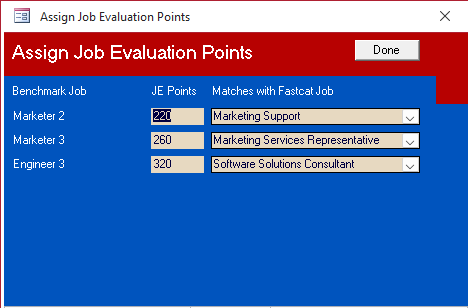

There may not be enough info here to solve it but all i need to know is how to find/what numbers are used to find the range and possibly correcting JE points upper and lower
The JE Points for each Job:

Im not sure if this would help:

Grades \& Ranges Grades \& Ranges Done Grades Number of Grades 3 \begin{tabular}{|ccccccc|} \hline GradeNumber & LowerJEPoints & UpperJEPoints & Range(%over/undermid) & Policy & \multicolumn{2}{c|}{ P } \\ 1 & 220 & 259 & 36 & Policy1 & \\ 2 & 260 & 319 & 20 & Policy 1 & \\ 3 & 320 & 359 & 25 & Policy1 & \\ \hline \end{tabular} Your assignment involves grouping jobs into grades. Describe how you did this, and why. List the job evaluation point cutoffs for each pay grade. Assign Job Evaluation Points Assign Job Evaluation Points Done Benchmark Job JE Points Matches with Fastcat Job Marketer 2 Marketer 3 Engineer 3 220 260 320 Marketing Support Marketing Services Representative Software Solutions Consultant Frades and Ranges Grades refer to a distance along the x axis, i.e., a division of job evaluation results (see Exhibit 22). Ranges refer to a distance along the y axis, i.e., dollar amounts that set the minimum and maximum pay permissible for a job within a grade. Grouping jobs into grades and establishing a pay range for each grade makes a system easier to administer. All jobs that fall within a grade are treated the same for com- How Many Grades and runges? pensation purposes. In order to design grades and ranges that make sense for FastCat, review the job structure you constructed in Phase I. Natural breaks in the job structure and the nature of the organization structure should help you determine how many grades to use and which jobs should be in which grades. Wider and fewer grades with larger pay ranges (on the right in Exhibit 22) are sometimes referred to as broadbands and are consistent with a more flexible organization structure, but provide fewer promotion opportunities and are less effective at controlling costs. Narrower grades (left; Exhibit 22) allow more frequent promotions and better cost control. Remember that any jobs that you assign to the same grade will be treated as if they are of equal worth to FastCat. What Size Ranges? Ranges have midpoints, minimums and maximums. Also important is the concept of Range Spread, defined as (Salary Range Maximum-Salary Range Minimum)/Salary Range Minimum. Exhibit 23 shows typical salary range spreads as a function of pay structure type (market-based is most common with a typical range spread of 55% ) and job level (larger spreads at higher job levels). Exhibit 23 Grade Range Spread Practices for Midpoints Common Pay Structure Types and Job Level The software calculates midpoints as the dollar amount at the point where the pay policy line crosses the center of each grade. In Exhibit 22, the midpoints are drawn in the grades on the left. If you choose a policy line above or below the regression line, the midpoint will automatically adjust. Midpoint Progression is the average percent differential between salary midpoints in adjacent grades/ranges. Exhibit 24 provides survey data on typical midpoint progression percentages used by organizations as a function of the type of pay structure they use. Most organizations use market-based structures with midpoint progressions that average around 15%. Also shown is the number of salary grades/ranges that would be needed using different midpoint progressions (using a case where midpoints go from 40,000 to 200,000). One would need 13 grades/ranges in this case. Minimums and Maximum World at Work, 2019; "2019 Survey of Salary Structure Range minimums and maximums (and midpoints) represent financial conPolicies and Practices." World at Work and Deloitte, 2019. trol points. Every job in a grade should be paid at least as much as the range Nis the number of organization respondents. minimum for that grade. No job in a grade should be paid more than the range maximum. Pay ranges also offer flexibility to adjust pay based on perRange spread =max/min1 formance. Two people doing the same job can receive different pay rates and still be within the pay range for their job. Larger ranges are used when there is considerable room for individual differences in performance or experience










